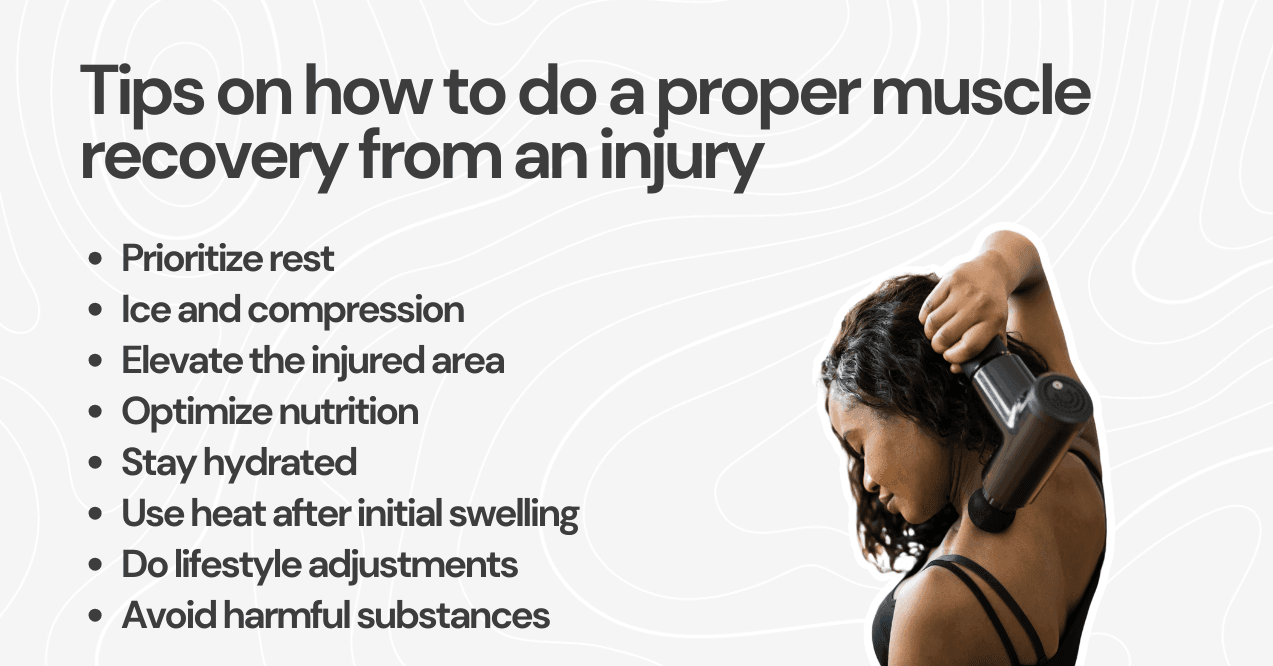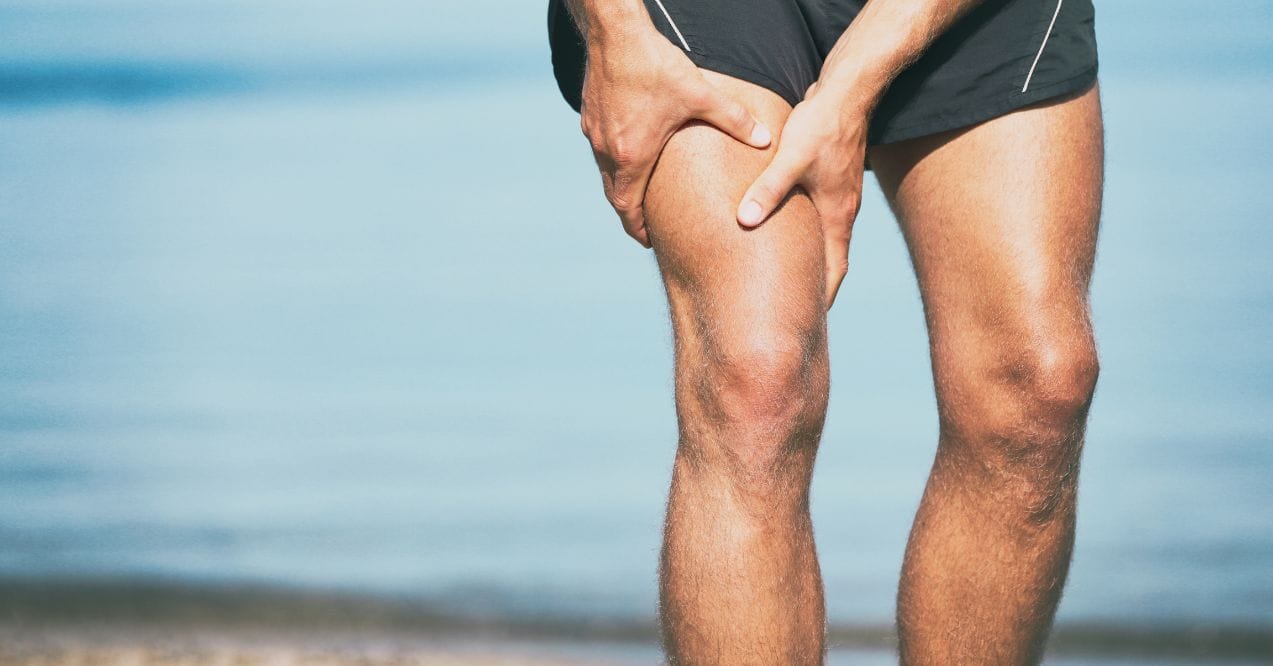Top Tips on How to Do a Proper Muscle Recovery From an Injury
Bouncing back after a muscle injury isn’t just about waiting it out – it’s about taking smart, proactive steps toward recovery. Whether you’ve pushed too hard during a weekend workout or tweaked something during your regular training, knowing how to do a proper muscle recovery from an injury can make all the difference in your comeback journey. The right approach not only helps you return to activity faster but also reduces your risk of reinjury.
In this guide, we’ll explore effective strategies to support your body’s natural recovery processes, boost your comeback timeline, and help you regain strength safely. Your path back to peak performance starts with these essential recovery principles.

What to do if a muscle doesn’t recover from injury?
Sometimes, despite your best efforts, a muscle injury might not improve as expected. If you’ve been following proper recovery protocols for several weeks but still experience persistent pain, weakness, or limited range of motion, it’s time to seek professional help. This is especially important if you notice increased swelling, redness, or unusual warmth around the injury site.
Understanding what to do if a muscle doesn’t recover from injury often involves consulting with a physical therapist or sports medicine specialist who can provide personalized assessment and treatment plans. These professionals can identify underlying issues that might be hindering your recovery and recommend specialized techniques like targeted exercises, manual therapy, or advanced recovery modalities.
Remember, lingering injuries shouldn’t be ignored – addressing them promptly with professional guidance can prevent long-term complications and help you return to your activities safely and confidently.
Tips on how to do a proper muscle recovery from an injury
Knowing how to do a proper muscle recovery from an injury may dramatically reduce your downtime and help you return to your training routine with confidence. The recovery process isn’t just about waiting – it’s about taking active steps to support your body’s natural healing mechanisms. Here are some proven strategies that could put speed up your recovery.
Prioritize rest and gentle movement
When injury strikes, your first instinct might be to push through the pain, but this approach often backfires. Initial rest is crucial to prevent aggravating the injury and causing further damage. However, complete immobilization isn’t always the answer.
After 24-48 hours, introducing gentle, pain-free movement helps maintain joint mobility and promotes blood flow to the injured area. This approach, sometimes called “active recovery,” can include light stretching or low-intensity movements that don’t cause pain. Listen to your body – if a movement hurts, back off and try something gentler.
Ice and compression
Applying ice is one of the most effective immediate recovery ways following a muscle injury. Cold therapy reduces inflammation and temporarily numbs the area, providing relief for issues such as knee and ankle pain. For best results:
- Apply ice for 15-20 minutes at a time
- Use a thin barrier between the ice and your skin
- Repeat every 2-3 hours during the first 48-72 hours
Pair icing with compression through elastic bandages or compression sleeves to further control swelling and provide structural support to the injured area.
Elevate the injured area
Elevation is a simple yet powerful technique in your recovery arsenal. By positioning the injured limb above heart level, you help reduce swelling by allowing excess fluid to drain away from the site. This is particularly effective when combined with ice and compression.
Try to elevate the area whenever you’re resting, especially during the first few days after injury. Even short periods of elevation throughout the day can make a significant difference in managing swelling and discomfort.
Optimize nutrition for recovery
Your body needs the right building blocks for muscle recovery after exercise or injury. Focus on:
- Protein-rich foods to support tissue repair
- Colorful fruits and vegetables that provide antioxidants to fight inflammation
- Omega-3 fatty acids that help moderate inflammatory responses
- Zinc and vitamin C, which play critical roles in tissue regeneration
Timing matters too – aim to consume nutrient-dense meals consistently throughout the day to provide your body with a steady supply of recovery resources.
Stay hydrated and use recovery-boosting drinks
Proper hydration is fundamental to every bodily process, including recovery. Water helps transport nutrients to damaged tissues and removes waste products. Consider incorporating:
- Water with electrolytes to replace minerals lost through sweat
- Tart cherry juice, which may help reduce muscle soreness
- Protein shakes that deliver amino acids for tissue repair
When looking for targeted support during your recovery journey, Trumeta Recovery offers a targeted approach. This specialized formula combines Vitamin C to support tissue repair and collagen synthesis with Magnesium to relax tense muscles and alleviate soreness.
The electrolyte blend helps rehydrate efficiently after exertion, while the carefully balanced nutrients work together to reduce recovery time between workouts. Simply mix with water after activity for a convenient recovery boost when your muscles need it most.

Use heat after initial swelling subsides
Once the acute phase has passed (typically after 48-72 hours), introducing heat therapy can enhance your recovery. Warm compresses, heating pads, or warm baths increase blood flow to the area, delivering oxygen and nutrients while helping to relax tight muscles.
Alternate between heat and ice for optimal results, particularly for persistent or stubborn injuries.
Support recovery with lifestyle adjustments
Recovery extends beyond specific treatments to include broader lifestyle factors:
- Prioritize 7-9 hours of quality sleep when your body performs most of its repair work
- Manage stress levels, as stress hormones can slow the healing process
- Consider recovery tools like foam rollers, massage guns, or compression garments to enhance circulation and tissue mobilization
Avoid harmful substances
Certain substances can significantly impede your recovery efforts. Alcohol can increase inflammation and dehydration, while tobacco restricts blood flow to tissues. Both can dramatically slow your healing time. Cutting back or eliminating these substances temporarily can make a substantial difference in how quickly you bounce back.
How to speed up muscle strain recovery?

Looking to fast-track your comeback? Knowing how to speed up muscle strain recovery often involves combining several approaches simultaneously rather than relying on a single method. Start by adhering to the RICE protocol (Rest, Ice, Compression, Elevation) during the first 48-72 hours, then gradually introduce gentle movement as pain allows.
Certain natural supplements may also support your recovery journey:
- Turmeric, ginger, and boswellia are considered to be effective herbs for muscle recovery
- Tart cherry extract can help reduce post-exercise soreness
- Bromelain (found in pineapple) has shown promise in supporting tissue repair
Don’t underestimate the power of consistency – following a structured recovery plan will yield better results than sporadic efforts:
- Focus on nutrient-dense foods that support repair
- Prioritize 7-9 hours of quality sleep nightly
- Stay well-hydrated throughout the day
- Perform appropriate physical therapy exercises regularly
Conclusion
Learning how to do a proper muscle recovery from an injury isn’t just about getting back to your workouts – it’s about building a stronger, more resilient body for the long run. By combining strategic rest, appropriate movement, proper nutrition, and targeted recovery techniques, you can transform an injury from a setback into an opportunity for growth.
Remember that patience is part of the process – rushing recovery often leads to reinjury. Listen to your body, adjust your approach as needed, and celebrate small wins along the way. With these strategies in your fitness toolkit, you’ll be better equipped to bounce back stronger whenever challenges arise.
Treat a torn muscle by immediately following RICE protocol – Rest, Ice, Compression, and Elevation. After initial recovery, gentle stretching and progressive strengthening exercises help rebuild tissue. Consider professional physical therapy for moderate to severe tears for optimal rehabilitation.
Regain muscle after injury through progressive resistance training, starting with light weights and gradually increasing intensity. Focus on proper form, balanced nutrition with adequate protein, and consistent workouts. Allow sufficient recovery time between sessions to prevent reinjury.
Recovery timeframes vary widely based on injury severity. Minor strains may heal in 2-3 weeks, while moderate tears typically require 3-8 weeks. Severe muscle injuries can take 3-6 months for complete recovery. Individual factors like age and nutrition also influence healing rates.
Advertisement. This site offers health, wellness, fitness and nutritional information and is designed for educational purposes only. You should not rely on this information as a substitute for, nor does it replace, professional medical advice, diagnosis, or treatment. If you have any concerns or questions about your health, you should always consult with a physician or other health-care professional. Do not disregard, avoid or delay obtaining medical or health related advice from your health-care professional because of something you may have read on this site. The use of any information provided on this site is solely at your own risk.







